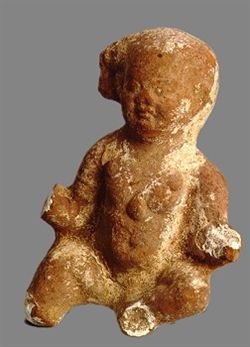
The name given to (statues of) fired clay. They appear rather late in Egypt, mainly under the influence of the Greek culture. As early as the 6th Century BC, Greeks in the town of Naukratis in the Delta were making terracottas. A large number of the finds come from Alexandria where there was a complete industry. The so-called Faiyum terracottas from the Graeco-Roman Period, named after the oasis, are also well-known. Terracottas were made both freehand and in moulds. With figures, the individual limbs were often made separately and then joined together. Many different types of terracottas have been found, including statuettes of people. These include the so-called grotesques, figures whose body proportions or abnormalities are depicted in a very exaggerated fashion. Then there are all kinds of animals, as well as various gods, the most popular being Harpocrates, Isis and Serapis. Further, there are portraits of kings and queens from the Ptolemaic Period, miniature houses and temples, pottery lamps, often decorated, etc. Opinion is divided about the reasons for making terracottas. Many statuettes were found in tombs, but just as many in houses. Nowadays it is assumed that there were various reasons for making them: as grave goods, votive objects, objects displayed in the home or in a sanctuary, amulets, etc. Of course, it is also possible for an object to be reused for a different purpose.